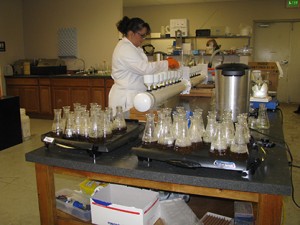A New Test For Ranking Forage Quality
By: Heather Smith Thomas
Hay quality has a big influence on animal performance—for health and body condition, growth of young horses, broodmares, stallions, show horses, etc. When selecting hay, horse owners often use analytical tests and look at the test results for crude protein (CP) and fiber components (ADF and NDF). Some laboratories use an index system that enables the client to compare the nutrient value of various batches of hay. The index gives you just one number that predicts the quality of a hay sample, making it simpler to evaluate and compare forages. Two indexes have been available for use in the past few decades. RFQ (relative feed quality) is a good equation, but costly, so most people use RFV (relative feed value) when evaluating forages. RFV has been the industry standard for more than 20 years.
A newer index works better, according to Fred Muller, DVM and Lynn Van Wieringen PhD (nutritionist) at Ag Health Laboratories in Sunnyside, Washington. Their lab has been doing feed analyses for many years and recently began using DOMI (Digestible Organic Matter Index), a formula created by Cumberland Valley Analytical Services (CVAS), a major feed analytic lab in Maryland.
Van Wieringen says it’s nice to have an index value, just one number, rather than having to compare multiple numbers. “If you are looking at different alfalfa hay samples, for instance, you may look at some of the various nutrient analyses, but it is nice to have one number to help with the ranking,” she says.
“We’ve known for quite awhile that there is a need for a different ranking system. One of the limitations when using RFV is that it merely looks at two fiber values—the ADF and NDF—to come up with the one number,” says Van Wieringen. “It does not take into account other nutrients in the hay, such as crude protein. It also does not take into account digestibility of the fiber. Another problem is that soil contamination (dust, etc. in the hay) will elevate the ash content and can skew the RFV value downward. A large portion of the ash will show up as fiber, in this test,” she explains.
By contrast, the DOMI gives a more accurate indication of hay value because it removes the ash and indigestible fiber from the equation. It looks at the digestible organic matter which contains the nutrients such as crude protein and readily available carbohydrates.
CVAS generally reports the DOMI as pounds of organic matter per ton of feed. “If you have a value of 1,300 pounds of digestible organic matter in a ton of hay, that would be better than hay with 1,100 pound value,” says Muller. This index makes it simple and easy to understand.
“A slide presentation on our website includes a graph that shows DOMI versus RFV on various samples. If you look at various feeds that have a RFV of 170, let’s say, there is a wide spread in the DOMI of those feeds. I use this chart to show people the variation between what the old RFV would tell you and the actual DOMI. Some of those feeds have very good DOMI numbers, and some are not as good as the RFV predicted,” explains Muller.
“If you pick a single DOMI, and then look at the range of RFV on various feeds, some of those will differ by 20 points. At 1,300 DOMI some of those samples will be as low as 140 RFV and some as high as 160 RFV. So which are you getting? You don’t really know, using that old index. We are excited about using the DOMI as a better tool to help people buy better feed than what we used to be able to predict with the old RFV index,” he says.
“Our goal is to help people more accurately evaluate forages so they can select better quality feed,” says Muller. “We want to help people implement feed analyses and interpret the results.”











